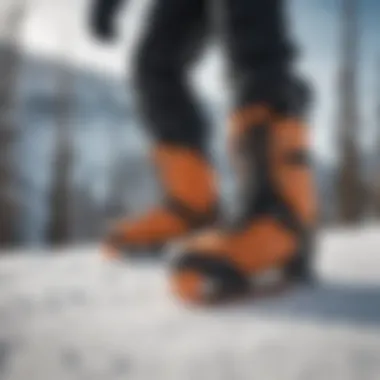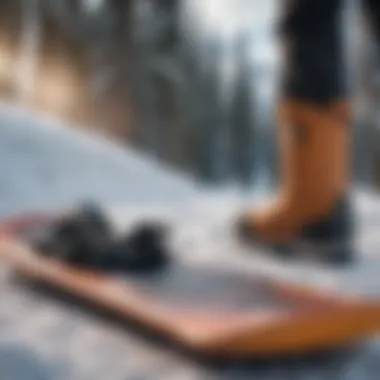Essential Snowboarding Gear for Beginner Riders


Intro
Snowboarding is an exhilarating sport. For beginners, having the right gear can make a significant difference in their experience. This guide focuses on the essential equipment, clothing, and accessories that can help novice riders feel safe and comfortable on the slopes. Before heading out, understanding what you truly need is imperative. This includes functional gear and selected brands that offer quality assurance.
Equipment and Gear
When stepping into snowboarding, the equipment becomes central. There are various types of gear that novices must consider. Here are the key components every beginner should secure:
- Snowboard: Selecting the right type is fundamental. Brands like Burton, Rossignol, and K2 offer options suited for beginners. Choose boards that are softer, making them easier to maneuver and control.
- Bindings: Choose compatible bindings to match your snowboard. Look for models from Flow or Union that are user-friendly.
- Boots: Comfortable and properly fitting boots are essential. Brands like Salomon and DC have beginner-friendly options.
- Helmet: For protecting your head from potential falls, a good helmet is non-negotiable. Smith and Giro are popular brands known for safety and comfort.
- Goggles: Protect your eyes from wind and snow glare. Models from Oakley and Anon can provide good visibility in various weather conditions.
Tips on Maintenance and Equipment
Washing your gear is crucial for durability. Pay special attention to the waterproofing of jackets and snow pants. Check your snowboard often for any signs of wear, and apply wax regularly for optimal performance. Also, feel free to upgrade as you progress in skill level. Various advancements in gear, like improved binding systems, can enhance your ride significantly.
"Only a well-maintained board will get you safely down the mountain."
Clothing and Accessories
The right clothing affetcs comfort and performance. Layering is the best approach. Start with a base layer such as thermal underwear, opt for a deep puffy jacket as a mid-layer, and finish with a waterproof outer shell. Notable brands include Columbia and The North Face.
Accessories that are important are gloves, ski socks, and neck gaiters. A good quality glove will keep your hands warm and somewhat dry, while specialized socks provide better fit and cushioning. Always take seam sealant for emergency situations.
By ensuring you have this crucial equipment and appropriate clothing, you establish a solid foundation for adventure in snowboarding, making your first experience positive. Beyond simple functionality, considering brand reputations and fit will save time and potentially some regret later on.
Prelims to Snowboarding Gear
Snowboarding gear serves as the foundation for an enjoyable and secure experience on the slopes. It is vital that beginners understand the essential components and their functions before embarking on their snowboarding journey. Proper gear not only enhances performance but also ensures safety, two crucial elements for new snowboarders who may encounter varied conditions on the mountain.
The Importance of Proper Gear
Having the right snowboarding gear protects against injuries and enhances overall performance. Novice snowboarders often overlook how gear influences their confidence and ability on the slopes. Proper equipment aligns with techniques and technique fosters improvement. A well-fitted snowboard reduces the risk of falls, helps with control, and encourages the development of skills. Additionally, essential components such as helmets and boots play a role in general safety during the ride. They provide both comfort and protection, crucial for those still learning how to tread the diverse terrains of ski areas.
Whether it’s waterproof jackets or high-quality bindings, without the right gear, there is an increased risk of slips, accidents, and even discomfort that can detract from the learning process. Ultimately, understanding this aspect can elevate a beginner's snowboarding experience from merely learning how to stay upright to mastering several techniques smoothly.
Understanding Snowboarding Basics
Beginners need a succinct grasp on snowboarding basics. This knowledge will inform their gear selections as they standardize their safety measures. Each piece of equipment plays a role in navigating the sport, from snowboards that dictate style to boots that influence balance. Before diving into purchasing decisions, learners should familiarize themselves with critical concepts, such as proper stance, turning techniques, and basic safety protocols.
Additionally, understanding how snowy conditions affect controlling the snowboard is indispensable. Beginners should recognize various terrain types and how their gear performs under these circumstances. Insights into the basics help inform better choices overall, ensuring they are equipped to handle fluctuations in speed and turns almost effortlessly. This prevailing comprehension mitigates overwhelming feelings that can often accompany learning a new sport.
Essential Snowboarding Equipment
Essential snowboarding equipment is crucial for beginners. The right gear can enhance performance and safety on the slopes. Selecting appropriate equipment ensures a more enjoyable learning experience. Beginners should consider their unique needs before investing in gear. Understanding various components can significantly impact skills development. A good setup can make all the difference when mastering snowboarding techniques.
Choosing the Right Snowboard
Selecting the right snowboard is an important step for any novice. A well-chosen board can facilitate better control and prevent frustration.
Types of Snowboards
There are several types of snowboards available. These include all-mountain, freestyle, and powder boards. Each type has unique characteristics influencing performance. All-mountain boards are versatile, suitable for various snow conditions. They are often recommended as a solid choice for beginners, offering ease of handling on different terrains. Freestyle boards, in contrast, excel in terrain parks, emphasizing tricks and creativity. While powder boards provide enhanced performance in deep snow, they may not be ideal for new riders still mastering their technique. When selecting a type, beginners need to consider their interests and the terrain where they will ride.
Length and Flex
The length of a snowboard affects maneuverability and balance. Beginners tend to choose shorter boards, which allow for easier turns. Flexibility also plays a significant role. Softer boards offer more forgiveness during mistakes. A softer flex is often a favourable choice for beginners as it absorbs impact and provides a smoother ride. Stiff boards, while more stable at high speeds, can be difficult for new riders to manage in turns. Hence, respecting one’s skill level will assist in selecting appropriate length and flex.
Tips for Beginners
Learning how to snowbaord can be daunting. Here are a few essential tips:
- Try Before You Buy: Renting gear may help make the best purchase.
- Check the Board Shape: Ensure the board aligns with skills.
- Consult with Experts: Talk to staff in sporting goods stores for insights.
Following these guidelines can improve the price to performance ratio when choosing gear. After mastering riding techniques, you can invest in specialized types of boards.
Bindings: A Key Component
Bindings connect the board to the boots and are essential for control and comfort.
Types of Bindings
Bindings primarily differ in style: strap-in, rear-entry, and step-on. Strap-in bindings are most common and provide reliable performance for beginners. They have multiple adjustable straps for a secure fit and reliable movement. Rear-entry bindings allow quick accessibility and can be easier to manage when putting on boots. Step-on bindings do not use traditional straps. Instead, riders step onto the binding to secure their boots. These types can simplify the process of getting on and off the board. When selecting bindings, think about your riding style and approach to gear setup.
Compatibility with Your Board
Before making a purchase, ensure compatibility. Most bindings will work with generic snowboard models, yet each brand has nuances. Reviewing detailed specifications helps avoid mismatches.


Determining compatibility assists in maintaining equipment performance, effectively producing optimal riding conditions.
How to Set Up Bindings
Proper setup contributes to maximizing comfort and control. Bindings should be configured based on personal riding stature and style. Important considerations include:
- Stance Width: determines your stance and balance.
- Angles: setting angles affects weight distribution.
- Position: Inspect how far back or forward they should be.
A correct and tailored binding setup ensures improved transitions, confidence when riding downhill, and more control.
Boots: Comfort and Performance
Boots are just as important as that board. Proper fitting boots make an extraordinary difference in performance and comfort.
Types of Snowboard Boots
Snowboard boots come in soft, medium, and stiff flex options. Soft boots are often more comfortable for beginners, allowing easier movement and adjustment. These designs provide comfort during climbs and reduce fatigue over long periods. Medium flex boots offer the perfect blend between audience needs while gaining skill. They remain an excellent option for aspiring riders focusing on versatile terrain. Stiff flex boots could be perfect for advanced riders requiring high-speed performance but may be less forgiving for those still learning.
Fit and Sizing
Boot fit is fundamentally vital. The right size ensures adequate ankle support and control while riding. Novaices should try boots on in-store and wear appropriate snowboarding socks. Ideal boots should feel snug without causing discomfort, supporting the foot throughout any ride.
A good fit prevents common problems like pain or loss of control when speeding down the mountain.
Breaking In Your Boots
New boots must be broken in to ensure maximum comfort. Spend initial time using them in controlled environments, such as local parks. Take short sessions to allow boots to mold to your feet. This process helps improve the overall feeling during subsequent rides on slopes. Ensuring overall comfort features the importance of this phase, which forms an effective groundwork toward improving future snowboarding experiences.
Snowboarding Apparel
Understanding the right snowboarding apparel is crucial for beginners engaging in this outdoor sport. It not only impacts comfort but also plays a significant role in performance and safety. Properly chosen clothing helps to regulate temperature, manage moisture, and protect against wind and cold. This section will delve into different components of snowboarding apparel. Each piece serves its specific function and contributes to a successful riding experience.
Outerwear: Jackets and Pants
When it comes to tackling winter elements, the selection of jackets and pants requires careful thought.
Waterproof and Breathable Fabrics
Waterproof and breathable fabrics are essential for snowboarding outerwear. Their main function is to keep you dry, allowing moisture to escape while preventing rain or snow from penetrating. Common materials like Gore-Tex serve this requirement effectively.
One key characteristic is their dual functionality. These fabrics block water while enabling breathability. Simply put, they prevent that clammy feeling some clothes give when sweating. This makes them a popular choice among snowboarders, especially beginners who may not yet be adept at managing their body heat.
The unique feature of such fabrics is their advanced construction. They are crafted with microscopic pores that allow water vapor to leave while keeping larger water droplets out. However, some cheaper alternatives may lack such efficiency, leading to discomfort during long rides in varied conditions.
Layering Strategies
Layering is a fundamental strategy in snowboarding apparel. By wearing multiple layers, you increase your capacity to regulate warmth efficiently. This approach suits beginners well, enabling them to adjust for different temperatures throughout the day.
One beneficial aspect of layering is its versatility. It allows athletes to customize as per the changing weather within minutes. An example could be shedding a mid-layer when the sun comes out or adding an additional layer when temperatures drop.
A notable disadvantage comes from improper layering. If too many layers are worn, mobility suffers. Conversely, too few layers may lead to exposure to cold, impairing performance and safety.
Fit and Mobility
The fit and mobility of snowboarding apparel critically impact performance on the slopes. Clothes should fit well without being overly tight. Loose garments might cause snagging, which can impede smooth movements when navigating turns and jumps.
A key characteristic is the consideration of the range of motion the attire provides. Jackets and pants designed with articulated joints allow for greater flexibility, essential for effective riding.
However, improper fit could pose a challenge. Both overly snug and excessively loose pieces may result in reduced comfort. Beginners must strive to balance tightness with the required range of motion.
Base Layers: Comfort Matters
Base layers constitute the first line of defense against cold weather. Their primary role focuses on ensuring comfort through effective moisture management.
Materials to Look For
The selection of materials for base layers deserves ample attention. Performance fabrics such as merino wool or specialized synthetic materials are often recommended. These fabrics possess inherent qualities that work to wick sweat away from the body and dry quickly.
One of the crucial benefits these materials offer is warmth without excessive bulk. Unlike standard cotton, they keep the wearer dry while adequately insulating. Therefore, beginners should look for items that utilize these advanced materials.
A distinctive negative of cotton base layers is their tendency to retain moisture, promoting chills during descents, which can lead to discomfort.
Importance of Moisture Management
Moisture management encompasses techniques crucial to both warming and cooling processes. This factor is particularly important during snowboarding, as athletes generate significant heat while striving for improved performance.


Selecting apparel designed specifically for moisture management enhances overall snowfall experiences. Such clothing works efficiently by drawing moisture away from the skin, allowing faster evaporation.
A unique downside presents itself when using non-specialized clothing: if moisture hangs close to the body, the risk of experiencing a chill increases greatly. Thus, it becomes increasingly crucial for beginners to prioritize this aspect.
How to Choose the Right Base Layer
Choosing an effective base layer often seems daunting. Evaluate thickness, material, and fit to suit your personal comfort and the weather conditions.
Thickness is an important characteristic here. Some prefer lightweight options in milder weather whereas mixing and layering thicker options during colder conditions might be wise.
For beginners, making mistakes in many matters of choosing base layers might occur. Getting a basic understanding of personal style or preferences initially can be impactful as one can then grow with their needs.
Accessories: Gloves, Hats, and Goggles
Accessories are crucial to enhancing your overall snowboarding experience. The right gloves, hats, and goggles will contribute significantly to support and comfort while in action.
Choosing the Right Gloves
Choosing suitable gloves involves safeguarding one of the most essential parts of your body, your hands. The materials should offer warmth while maintaining dexterity for grasping poles or fastening bindings.
A key characteristic to consider is insulation. Products that provide thermal protection without bulky design will be ideal, keeping your hands warm without losing flexibility. Waterproof options enhance usability by preventing wetness if catching a fall or switching snow levels. An alternative could mean great inconvenience, limiting effectiveness in snowboarding practices throughout the day.
Hats and Helmets for Safety
The adoptions of hats and helmets is vital for both comfort and safety. Wearing a helmet considerably reduces the risk of head injuries, which can severely affect your snowboarding longevity and enjoyment.
A prominent feature lies in the emphasis on fit. Helmets must ensure they fit correctly, protecting the entirety of the head while allowing for comfort for prolonged periods.
Regarding visible safety, neglecting helmet obligations can lead to grim outcomes. More severe implications might occur due to avoidable risks.
Selecting Goggles for Visibility
Visibility levels are critical considering weather conditions and lighting on the slopes; thus, goggles really matter.
Choosing correct tints is part of selecting the best option for paradinamic crazy adventures in snowboarding. Different tints serve various functions like high contrast or mirror finishes across clear and cloudy condition organization.
Losing visibility impairs essential handling and track living on wider terrains; failing to select wisely may hinder efficiency on the slopes and consequently put new beginners at risk.
Safety Gear for Beginners
Safety gear plays a crucial role for novice snowboarders. Its importance cannot be overstated. Many beginners often overlook safety gear while focusing on their equipment. However, proper safety gear significantly reduces the risk of injury, making early experiences more enjoyable and encouraging continued participation in the sport.
The Necessity of Helmets
Wearing a helmet is essential for every snowboarder, especially beginners. They find themselves in scenarios where falls happen quite often. A helmet provides protection against potential head injuries. The certainty of falling makes it crucial for new riders to invest in a quality helmet.
Types of Helmets
There are various types of helmets available on the market. Ski and snowboard helmets are specifically designed with additional features for snow sports. One important characteristic of these helmets is their reinforced construction. This contributes to the overall safety by absorbing impacts effectively. In addition, some helmets come with built-in audio systems or adjustable vents, making them popular choices. It is vital to choose a helmet that fits snugly without being overly tight.
Proper Fit and Sizing
Helmets should have the right fit to ensure maximum safety. A properly fitted helmet means it rests flat on the head and does not move around during activities. A critical characteristic of proper fit involves using an adjustable dial or strap mechanisms for customization. Getting the right size not only enhances comfort but also provides better protection in case of falls. An improperly fitted helmet can slip during an impact, rendering it less effective in ensuring safety.
Wrist Guards and Impact Shorts
Wrist injuries are common among novice snowboarders due to falls. Therefore, wearing wrist guards is a great safety precaution. They help brace the wrists during impacts, significantly reducing the risk of fractures.
Benefits of Wrist Guards
The benefits of using wrist guards are clear. They not only provide support but also help prevent hyperextension of the wrist. This is particularly useful for beginners who may not yet have mastered falling techniques. Wrist guards are made with sturdy materials that absorb shocks upon impact, making them beneficial for retaining mobility while minimizing risks. The risk of injury outweighs any concerns about comfort since handlebars can feel slightly bulky, but the protection is worth it.
Importance of Impact Shorts
Lastly, impact shorts offer further protection to snowboarders. These specially designed garments cushion against falls. The foam padding within them absorbs shocks, especially for first-time riders who frequently land on their rear. Wearing impact shorts can help reduce bruises and trips to emergency rooms. They ideally fit snugly under other snow gear, maintaining a full range of motion.
In summary, wearing proper safety gear, like helmets, wrist guards, and impact shorts, is vital for beginners. It not only enhances confidence but also ensures that safety is prioritized on the slopes.
Selecting Gear Based on Skill Level
When embarking on the journey of snowboarding, the right gear can significantly affect one’s learning experience. Selecting gear based on skill level is paramount in achieving both safety and enjoyment. Beginners need equipment that enhances their stability and control, while more advanced riders can explore materials and designs that align with their experience. This tailoring of equipment allows riders to maximize their performance in accordance with their evolving skills.
Essential Gear for First-Time Riders
For those just entering the world of snowboarding, certain items are essential. An entry-level snowboard is typically designed to be stable and forgiving. These boards generally have softer flex, making them easier to maneuver. Look for brands like Burton and K2 that offer specific models for beginners. Moreover, many shops provide rentals. This is a wise option to consider for first-timers. In addition to the snowboard, it's crucial not to overlook the importance of appropriate boots and bindings.


Boots suitable for beginners often emphasize comfort and cushioned support. Fitting snugly while still allowing movement is important; beginners want to ensure they can flex their ankles without being restricted. Some well-regarded models come from Northwave and Salomon.
Bindings should complement the flex of the snowboard. They need to be straightforward and reliable. Beginners should focus on clip-in models or adjustable straps, which help lighten the learning curve. Also, always get professional guidance regarding men and women specific equipment fitment since both can have different hardware requirements.
Another essential component is safety gear. Wearing a helmet is non-negotiable. It protects against falls that can enhance the fall experience. Adding wrist guards can prevent serious injuries since wrist injuries are a common occurrence in beginners. This basic ensemble forms a strong foundation for a pleasant snowboarding initiation.
Advancing Your Gear with Experience
As riders progress with their skills, the need often arises to upgrade snowboarding gear to meet their growing demands. Experienced snowboarders tend to choose stiffer boards that facilitate better control at high speeds. Switching to a performance-oriented board often leads to improved ride precision. Many notable brands such as Lib Tech and Ride produce high-quality advanced boards.
Bindings also become a focal point since as skill level advances, the necessity for responsiveness increases. Better bindings provide optimal energy transfer from the legs to the snowboard. Appropriately weighted bindings help match the rider’s aggressiveness on the slopes.
In terms of boots, well-fitted high-performance types are a must. They provide support and control, essential for intricate maneuvering. As snowboarders gain confidence, investing in advanced technical gear becomes a top priority. All this scaffolds not just enhanced performances, but also elevates the overall experience on the slopes.
Important: Always choose gear upgrades based on feedback from your riding style and experienced advice from professionals. This allows focused customization of additional tech features into your gear.
Gear selection and advancement tailored to one’s skill level is not merely a process; it plays a critical role in shaping one’s success and longevity in snowboarding. Beginners should start with basics, while those with years of practice should refine their personal collection to cater to technological improvements.
Budget Considerations for Beginners
Budget considerations are crucial when selecting snowboarding gear, especially for beginners. Cost plays a prominent role in the decision-making process. Finding quality equipment without overspending can significantly affect both safety and performance on the mountain.
Prioritizing a budget helps in narrowing down choices that fit financial constraints. It ensures newcomers can enjoy the sport without feeling financial strain. Many beginners may not realize how starting off with subpar gear can negatively influence their experience. Investing just a bit more initially can lead to much better results.
Quality vs.
Price
When it comes to snowboarding gear, it is vital to strike a balance between quality and price. Higher-priced items often correlate with better performance, safety features, and durability. However, this does not imply that all affordable items lack necessary attributes.
Here are some considerations when evaluating cost comparisons:
- Longevity: Higher-priced equipment may last longer due to better materials or construction.
- Performance: Better-designed gear usually supports improved ease of use and learning.
- Comfort: Investing in quality snowboard boots, for example, can enhance comfort significantly.
Conversely, beginners can look for specific features essential for their initial experience. This awareness helps avoid overspending on advanced gear that may sit unused once skills improve.
Where to Buy: Retail vs.
Online
Deciding whether to purchase gear at retail stores or online presents a challenge. Both avenues have their pros and cons. Retail shops allow for hands-on testing of gear. One can feel the fit of snowboard boots and try on various jackets before buying. Moreover, staff at dedicated snow shops often provide valuable feedback and recommendations.
On the other hand, online shopping can be advantageous in terms of price. E-commerce stores frequently run discounts and can provide a broader range of gear. However, one should always verify sizing and compatibility carefully.
Consider these approaches when purchasing snowboarding gear:
- Retail Stores: Great for trying before buying. Ask questions to knowledgeable staff.
- Online Retailers: Possibility of lower prices and access to wider selection. Always confirm return policies in case products do not meet expectations.
Selecting the best option involves understanding personal needs and preferences. Happy shoppers save money and enjoy themselves on the slopes.
**
Closure
The conclusion of this article is essential as it synthesizes the critical elements of snowboarding gear for beginners. It wraps up discussions regarding equipment, safety, and comfort.
One should note that proper gear and clothing directly enhance your experience on the slopes. Using suitable snowboard, boots, and protective equipment minimizes risks and maximizes enjoyment. Investing in quality gear can enhance performance while ensuring safety.
Moreover, this guide emphasizes that newcomers need to approach purchases judiciously. The guide suggests focusing on quality rather than just price. It encourages beginners to consider both leisure and long-term participation.
"Being well-equipped enhances not just performance but also builds confidence."
Understanding the basics and continuing to educate oneself can lead to significant advancements in skill and pleasure. To enjoy snowboarding, awareness and preparedness with appropriate gear is pivotal.
Final Thoughts on Gear
In summary, selecting the right snowboarding gear lays a strong foundation for beginners. With equipment ranked by essential needs— from boards, bindings, to boots—aspiring snow bum can find themselves properly guided. Ensuring the equipment is suitable for one’s specific skill level and style of riding is fundamental.
New snowboarders should devote time to researching options. Learning about product specifications and engaging with expert opinions can bring clarity. Simultaneously, practical trying on is invaluable especially for apparel.
- Consider the environmental conditions for selecting outerwear.
- Opt for a base layer that ensures moisture wicking and adequate warmth.
This systematic approach will assist beginners in making informed choices.
Encouragement for New Snowboarders
Every journey starts with a first step. Snowboarding is no different. While the initial challenges can seem intimidating, persistence and focus yield rewards. Remember, every experienced rider was once in the same position as they learned the dynamics of the sport.
Embrace the learning curve. Training on practical skills and safety measures can positively impact confidence levels.
- Do not shy away from asking for tips.
- Community resources, like forums and groups on platforms like Reddit, can be valuable for advice.
- Take online resources seriously. Engaging with likeminded individuals enhances motivation.
As the stoke continues to grow, honour any small progress made. Whether linking turns or maintaining balance, every achievement counts. Maintain, practice, and seek out clinics or lessons to further refine technique.















